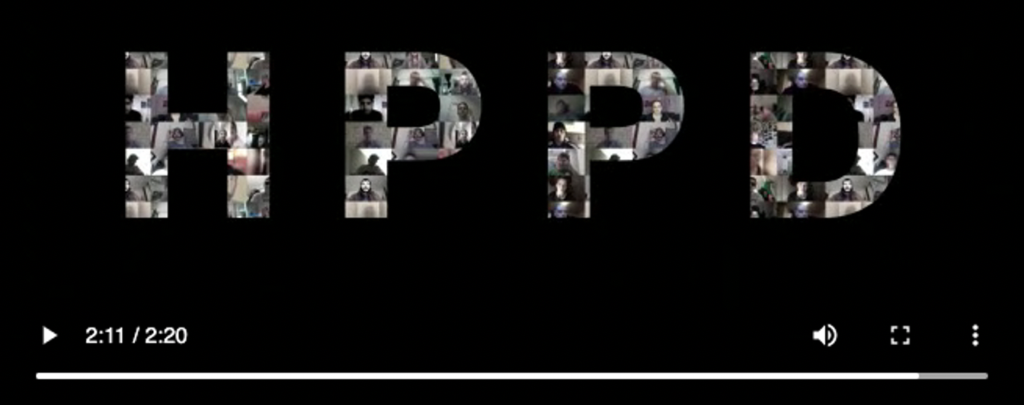
Robin Lefferts
August 30th, 2021
Exclusive, News, Psychedelics, Top News

Psychedelics, including ketamine, psilocybin, and LSD, are gaining traction in the mental health industry as they have been found to be potentially beneficial for conditions ranging from depression to anxiety to PTSD to alcoholism. As psychedelics are entering the mainstream of science and health, more is being discovered about a condition called Hallucinogen Persisting Perception Disorder (HPPD). For some people, estimated to be in the 4% range of all users, the psychedelic experience persists long after the drug has worn off.
Not much is known about the mechanisms of HPPD. The condition was described as persistent ‘flashbacks’ in the 50’s and 60’s but was only recognized as an official syndrome in 2000. There is currently no standard of care With the rise of psychedelics as therapy, more research and study is needed to define HPPD, identify its causes, and develop effective treatments.
One company leading the charge is Ehave, Inc. (OTC: EHVVF). Ehave specializes in digital and remote therapies for the mental health and psychedelic sectors powered by its mental health informatics platform. The company utilizes artificial intelligence and machine learning to enhance the treatment experience for patients, providers, and even insurers. Ehave is partnering with the University of Melbourne on a one year, three stage study to further define HPPD and develop a standardized test for the condition.
Click the image below to watch a video about HPPD
What is Known about HPPD?
LSD was first prepared in 1938, and research into its potential benefits began not long after. By 1954 cases of persistent hallucinogenic symptoms had been observed. In 1969, Dr. Mardi Horowitz introduced the term ‘flashbacks’ to the scientific lexicon to describe recurrent imagery from a psychedelic experience. He broke them down into three categories: (a) perceptual distortions (e.g., seeing halos around objects); (b) heightened imagery (e.g., visual experiences as much more vivid and dominant in one’s thoughts); and (c) recurrent unbidden images (e.g., subjects see objects that are not there).
In 2000, HPPD was finally defined as a long-lasting and potentially permanent syndrome that meets these criteria:
A) following cessation of use of a hallucinogen, the reexperiencing of one or more of the perceptual symptoms that were experienced while intoxicated with the hallucinogens (e.g., geometric hallucinations, false perceptions of movement in the peripheral visual fields, flashes of color, intensified colors, trial images of moving objects, positive after images, halos around objects, macropsia, and micropsia);
B) the symptoms in criterion (A) cause clinically significant distress or impairment in social, occupational, or other important areas of functioning;
(C) the symptoms are not due to a general medical condition (e.g., anatomical lesions and infections of the brain, visual epilepsies) and are not better accounted for by another mental disorder (e.g., delirium, dementia, schizophrenia) or hypnopompic hallucinations.
People suffering from HPPD often experience depression, panic, unease, and dissatisfaction as a result of these recurring hallucinations, and understandably so. HPPD may cause physical changes in the brain that affect visual processing, but more study is needed. Additionally, though the phenomenon was first noted in LSD users, there are many other substances that can trigger the condition, including ecstasy, psilocybin, synthetic cannabinoids, and other novel psychedelic substances.
What We Need to Learn
Many aspects of HPPD remain unknown and undefined. There is no clear and direct way to diagnose the syndrome without engaging in a battery of expensive and time consuming tests to rule out other potential causes, including all manner of brain and neurological disorders. To get to that stage, studies like the one Ehave is starting are essential. The study is designed to gather data and biomarkers that can target and diagnose HPPD more directly than is currently possible. Researchers hope to develop a screening protocol that can sort through self-reported symptoms to diagnose the underlying condition quickly and accurately. That is a start, and an essential step in working toward an effective treatment.
Ehave is also investigating whether there is a genetic predisposition in HPPD patients. Stage two of the study aims to incorporate genetic samples from both the control group and the HPPD group into the analysis. Should the study prove fruitful, the genetic markers could be used to prevent the onset of HPPD in patients seeking psychedelic treatments for other conditions like depression and PTSD. The last thing those patients need is to add another disorder as a result of the treatment for one they already have.
Click here to receive an investor presentation and corporate updates from EHave
The overall goal of the study is to develop a repeatable, efficient, commercially-viable way to test for and identify HPPD. Such a test would go a long way toward understanding just how prevalent the disorder is, identifying its causes, and developing an effective treatment. Currently, there is no sure treatment. Some patients experience benefits from taking anti-seizure medications, but the benefits are not uniform and the successes don’t constitute the majority.
Another benefit of an accessible and standardized testing regimen would be the removal of social barriers to even discussing the disorder. Like many mental health conditions, those who suffer from HPPD are often reluctant to discuss their experiences lest people think they are ‘crazy.’ By defining and identifying the disorder, online testing could help remove some of the hesitation and encourage more people to seek solutions without having to undergo a battery of physical and psychological tests.
The Upshot
For Ehave, all of the data and information gathered during the study will only add to the capabilities of its mental health technology platform, the Ehave Infinity Portal. Should the studies create a test capable of identifying HPPD it would become an important addition to the company’s arsenal of mental health data, HIPAA-compliant records, and machine learning-powered recommendations.
Ehave is pushing forward on a number of fronts, utilizing data and artificial intelligence to improve mental health treatments with effective remote tools. The company’s recent agreement to incorporate the Vastminz system into its offerings is indicative of the wide range of possibilities for the platform. Vastminz remotely analyzes facial skin to quantify health indicators like heart rate and blood oxygen saturation, bypassing the need for physical examination in many cases.
Ehave operates at the intersection of several emerging trends. Mental health concerns have been on the rise in general, and especially in light of the pandemic. Remote health care has been growing exponentially in general, and once again especially in light of the pandemic. Artificial intelligence is everywhere in our lives and spreading quickly. Psychedelic treatments for mental and neurological conditions are becoming more prevalent. Keep an eye on Ehave as it endeavors to make people happier and healthier.
Click here to receive an investor presentation and corporate updates
Disclaimer
The above article is sponsored content. CannabisFN.com and CFN Media, have been hired to create awareness. Please follow the link below to view our full disclosure outlining our compensation: http://www.cannabisfn.com/legal-disclaimer/
This article was published by CFN Enterprises Inc. (OTCQB: CNFN), owner and operator of CFN Media, the industry’s leading agency and digital financial media network dedicated to the burgeoning CBD and legal cannabis industries. Call +1 (833) 420-CNFN for more information.
About Robin Lefferts
Robin Lefferts has been involved in the legal cannabis industry since 2012, sometimes as an active participant and always as an interested observer.
MJ Shareholders
MJShareholders.com is the largest dedicated financial network and leading corporate communications firm serving the legal cannabis industry. Our network aims to connect public marijuana companies with these focused cannabis audiences across the US and Canada that are critical for growth: Short and long term cannabis investors Active funding sources Mainstream media Business leaders Cannabis consumers










